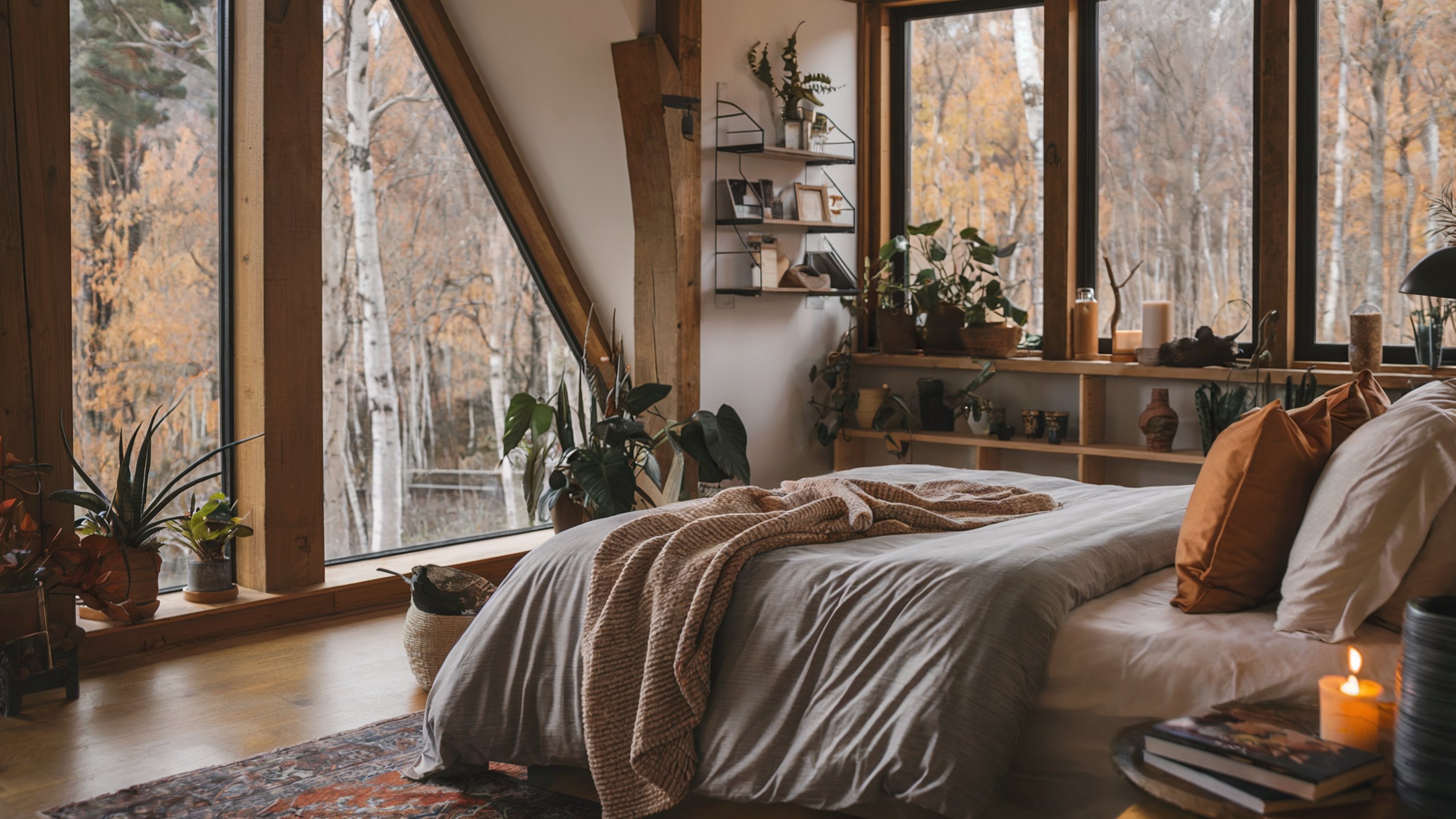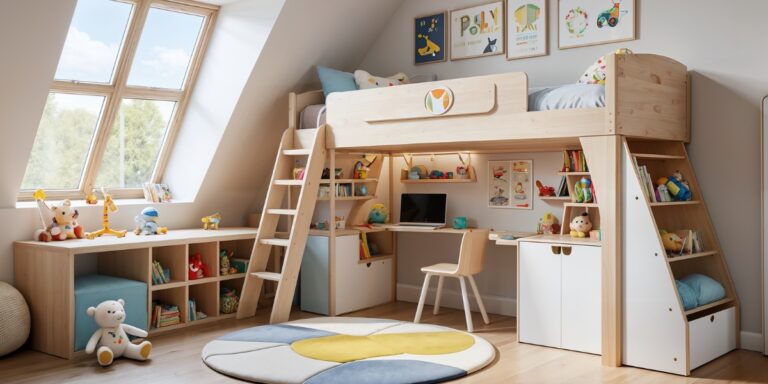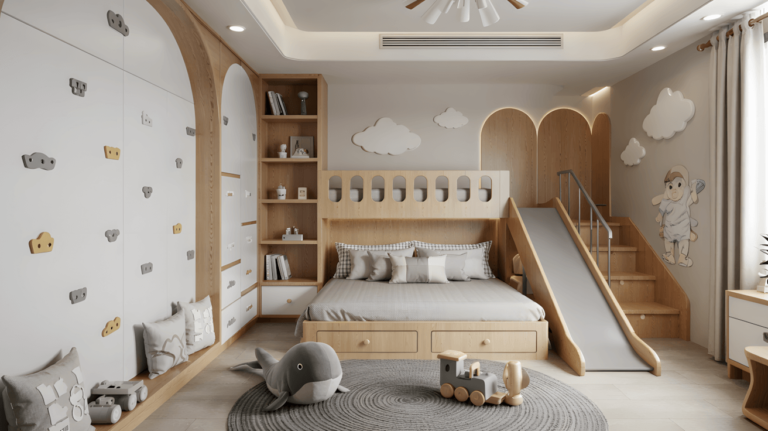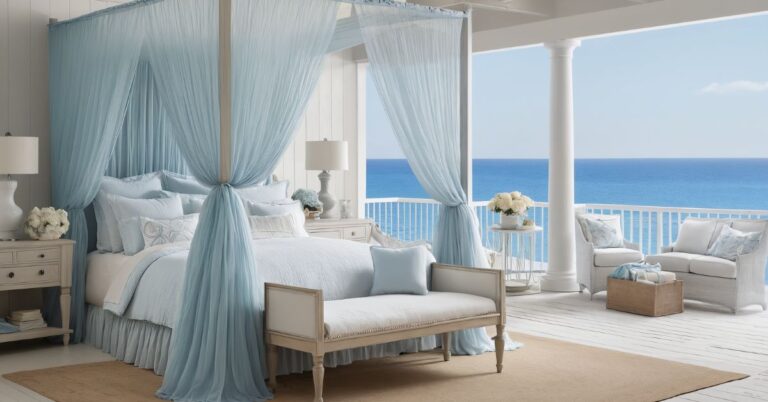After helping homeowners create cozy, nature-inspired bedrooms over the years, I’ve discovered that cabin-style design offers something truly special—the ability to bring the tranquility and warmth of the outdoors inside.
There’s something deeply satisfying about creating a space that feels like a peaceful retreat from daily life, where natural materials and earthy tones work together to promote genuine relaxation.
In my experience working with various bedroom transformations, I’ve learned that successful cabin-inspired design isn’t just about adding wood and plaid patterns.
It’s about creating a cohesive atmosphere that balances rustic charm with practical comfort, ensuring the space works for real daily living while maintaining that coveted retreat feeling.
These 20 cabin bedroom ideas represent approaches I’ve found effective in creating spaces that truly feel like personal sanctuaries, each offering unique solutions for different preferences and room layouts.
Note: For any structural modifications, electrical work, or installations mentioned in this article, always consult with licensed professionals to ensure safety and code compliance.
1. Rustic Retreat with a Forest View

The foundation of this approach often centers around maximizing natural views and light. Large windows can transform a bedroom by creating visual connections to outdoor spaces, making rooms feel more expansive and serene.
Wooden beam ceilings add architectural character, while gray and orange bedding combinations can create sophisticated color palettes that complement natural wood tones. The key often lies in balancing warm and cool tones to prevent spaces from feeling either too stark or overwhelming.
Design consideration: Curated shelving with plants and books can add personality while maintaining the natural theme, though plant selections should consider available light levels.
Window installation note: Large windows may require structural modifications and should be professionally assessed for load-bearing considerations.
2. The Rustic Charm of Wooden Elements

This approach embraces wood as the primary design element throughout the space. Wooden wall panels paired with exposed ceiling beams can create immersive natural environments, though proper ventilation and humidity control become important considerations.
White bedding against wooden backgrounds often creates pleasing contrast while keeping spaces feeling fresh rather than overwhelmingly dark. Natural light through appropriately sized windows helps prevent wood-heavy rooms from feeling closed in.
Material consideration: Different wood finishes should typically coordinate within similar tone families to maintain visual harmony rather than competing with each other.
Professional installation recommended: Extensive wood paneling may require proper moisture barriers and ventilation planning.
3. Snowy Paradise Inside a Cozy Cabin

This cozy approach combines visual warmth through textiles with the romance of winter views. Plaid and checkered patterns can add traditional cabin charm, though mixing patterns typically works best when they share similar color palettes.
Wood-burning stoves or fireplaces can provide both warmth and ambiance, though they require proper installation and maintenance for safety. Multicolored rugs can add warmth and comfort underfoot while contributing to the layered, cozy feeling.
Safety consideration: Real fireplaces require professional installation, proper ventilation, and regular maintenance for safe operation.
Professional requirement: Wood-burning stoves and fireplaces must be installed by certified professionals and inspected regularly.
4. A Serene Cabin Haven

This approach prioritizes natural light and calm color combinations. Plaid patterns paired with solid colors can create visual interest without overwhelming the space, particularly when colors complement the natural wood elements.
Framed landscape photography above beds can reinforce the nature connection while adding personal touches. Vibrant rugs can provide color contrast against wooden floors and walls, helping to define sleeping areas within larger spaces.
Layout tip: Consider the viewing angles from the bed when positioning artwork and windows to maximize both comfort and visual appeal.
5. A Cozy Rustic Bedroom Nook

Small spaces often benefit from embracing their intimate scale rather than fighting it. Fairy lights can add gentle ambiance, while wooden walls and ceilings create cocoon-like feelings that many find comforting.
White bedding in wood-heavy spaces often provides visual relief and prevents spaces from feeling too dark. Colorful rugs can define floor areas and add comfort, particularly important in smaller spaces where every element contributes significantly to the overall feeling.
Small space strategy: Light-colored textiles and strategic lighting can help prevent small wooden spaces from feeling cave-like.
6. Modern Cabin with Rustic Roots

This fusion approach shows how contemporary elements can work within rustic frameworks. Triangular windows can provide dramatic architectural features while flooding spaces with natural light, though they may require custom treatments for privacy.
Lofted beds can maximize floor space in smaller rooms while creating interesting vertical elements. Metal railings paired with wood can add contemporary touches while maintaining safety, though style coordination helps prevent jarring contrasts.
Safety note: Lofted beds require proper structural support and safety railings that meet local building codes.
Professional consultation: Loft construction and custom windows typically require professional design and installation.
7. Burnt Orange Beauty in a Rustic Setting

This approach demonstrates how bold, warm colors can work effectively in rustic settings. Burnt orange bedding against dark wooden walls can create dramatic yet cozy environments, though adequate lighting becomes important to prevent spaces from feeling too dark.
Ornate lighting fixtures can add elegance to rustic spaces while providing necessary illumination. The contrast between refined fixtures and rustic materials often creates appealing visual tension when balanced carefully.
Color balance: Bold warm colors typically work best when balanced with adequate lighting and some neutral elements to prevent overwhelming effects.
8. Intricate Designs Meet Rustic Style

This approach combines detailed elements with rustic foundations. Tufted headboards can add sophisticated comfort, while ornate wall sconces provide both functional lighting and decorative interest.
Mixed bedding in coordinated color palettes—white, black, and brown combinations—can create sophisticated looks while maintaining warmth. Framed artwork and small plants can add personality without overwhelming the detailed elements already present.
Design balance: When combining intricate details with rustic elements, limiting the overall color palette often helps maintain visual harmony.
9. Soft and Cozy Cabin Comfort

This approach uses color psychology to create calming environments. Blue bedding can promote relaxation, while weathered wood adds character and texture without being overwhelming.
Dried plant decorations can maintain natural themes year-round without the maintenance requirements of live plants. Simple framed art arrangements can add visual interest while complementing rather than competing with natural materials.
Maintenance consideration: Weathered wood finishes may require periodic treatment to prevent further deterioration while maintaining their attractive appearance.
10. Classic Rustic Elegance

This timeless approach combines traditional patterns with natural materials for lasting appeal. Plaid patterns paired with solid colors often create balanced, comfortable environments that don’t feel tied to specific trends.
Landscape photography can reinforce connections to nature, while patterned rugs add personality and comfort. The combination typically works well for those wanting classic cabin aesthetics that will remain appealing over time.
Timeless design: Classic combinations often provide better long-term satisfaction than trend-dependent choices, particularly in bedrooms where comfort and relaxation are priorities.
11. Wooden Elegance in Every Detail
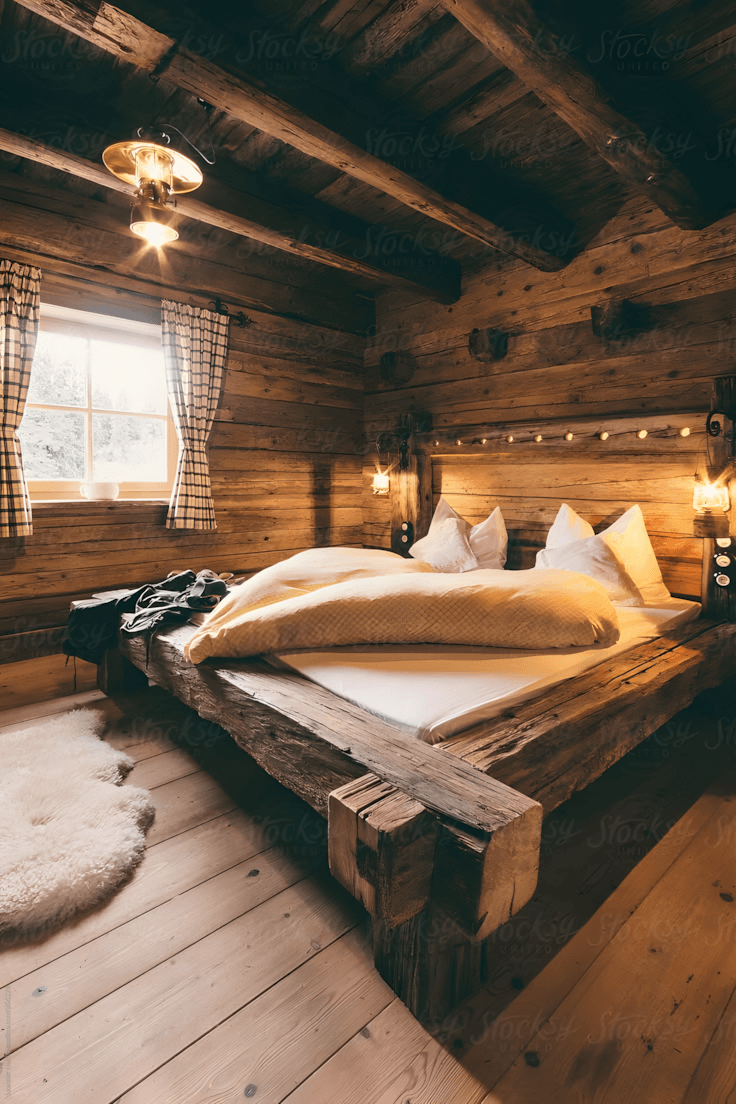
This comprehensive approach uses wood throughout while adding strategic color accents. Yellow blankets can provide cheerful contrast against natural wood tones, while checkered curtains add pattern interest and light control.
Vintage lighting fixtures can add character and appropriate scale in wood-heavy environments. The combination of different wood elements—beams, furniture, and fixtures—typically works best when finishes coordinate rather than match exactly.
Lighting consideration: In wood-heavy rooms, adequate lighting from multiple sources often prevents spaces from feeling too dark or closed in.
12. Nature-Inspired Green Serenity
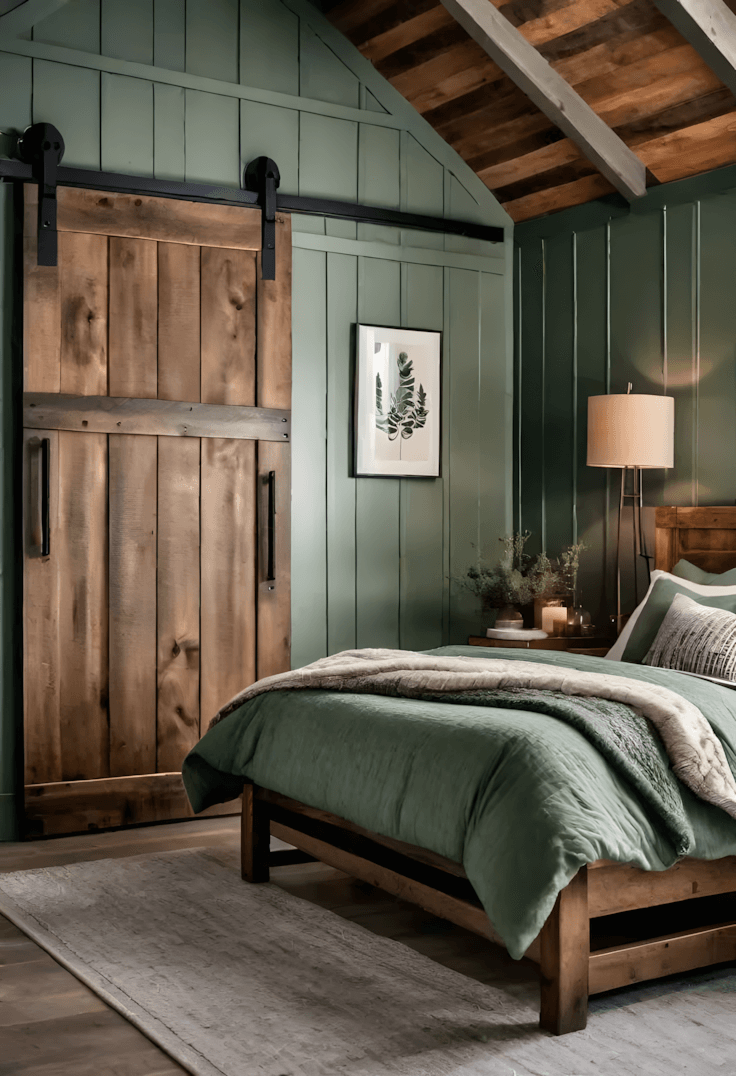
This approach uses color to reinforce natural connections. Green color palettes can create calming, nature-inspired environments, while wooden elements provide warmth and texture.
Botanical artwork can strengthen theme connections, while textured throws add comfort layers. Sliding doors can save space while adding functional architectural interest, though they require proper installation for smooth operation.
Color psychology: Research suggests green tones may promote relaxation and stress reduction, making them potentially good choices for bedroom environments.
13. Attic Bedroom with Skylights

This approach maximizes challenging architectural features. Exposed wooden beams can become attractive design elements rather than obstacles, while skylights provide natural light without requiring wall space.
Blue and white bedding combinations often feel fresh and airy, important considerations in spaces that might otherwise feel constrained. Wooden bookshelves can add both storage and character while working with rather than against the architectural elements.
Architectural consideration: Skylights require proper installation and weatherproofing to prevent leaks and energy loss.
Professional installation essential: Skylights involve roof modifications that require experienced contractors and proper permits.
14. A Floral Touch in a Rustic Bedroom

This approach shows how feminine elements can work within rustic frameworks. Dark wood paneling creates dramatic backgrounds, while floral patterns add softness and visual relief.
Wooden frame mirrors can maintain material consistency while reflecting light to brighten darker spaces. The combination of various textures and colors in bedding can create rich, layered looks without overwhelming the natural materials.
Design balance: Floral patterns often work best in rustic settings when they share colors with the existing palette rather than introducing entirely new color schemes.
15. Sloping Ceilings and Cozy Comfort
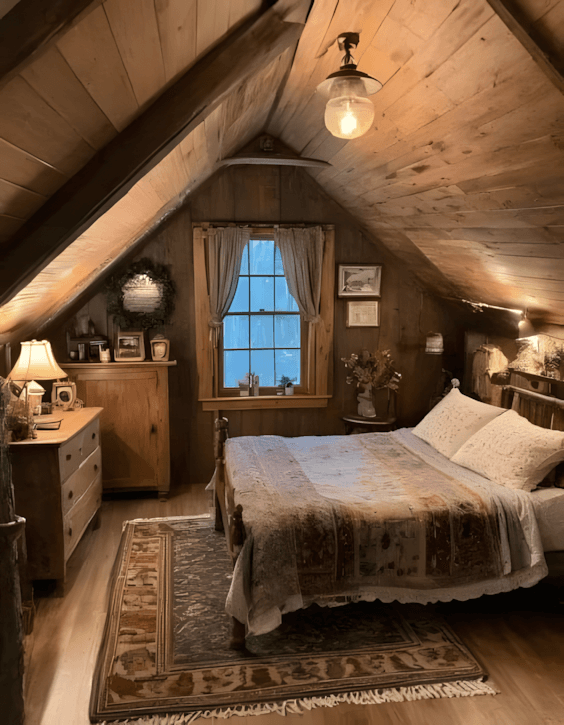
This approach embraces architectural challenges as design opportunities. Sloping wooden ceilings can create intimate, cozy feelings, while multicolored quilts add visual interest and comfort.
Wooden dressers provide necessary storage while maintaining material consistency. Natural light filtering through windows helps prevent sloped ceiling spaces from feeling too enclosed or cave-like.
Design opportunity: Sloped ceilings often create cozy, intimate feelings that many people find particularly restful in bedroom environments.
16. Wild Elegance in a Rustic Bedroom
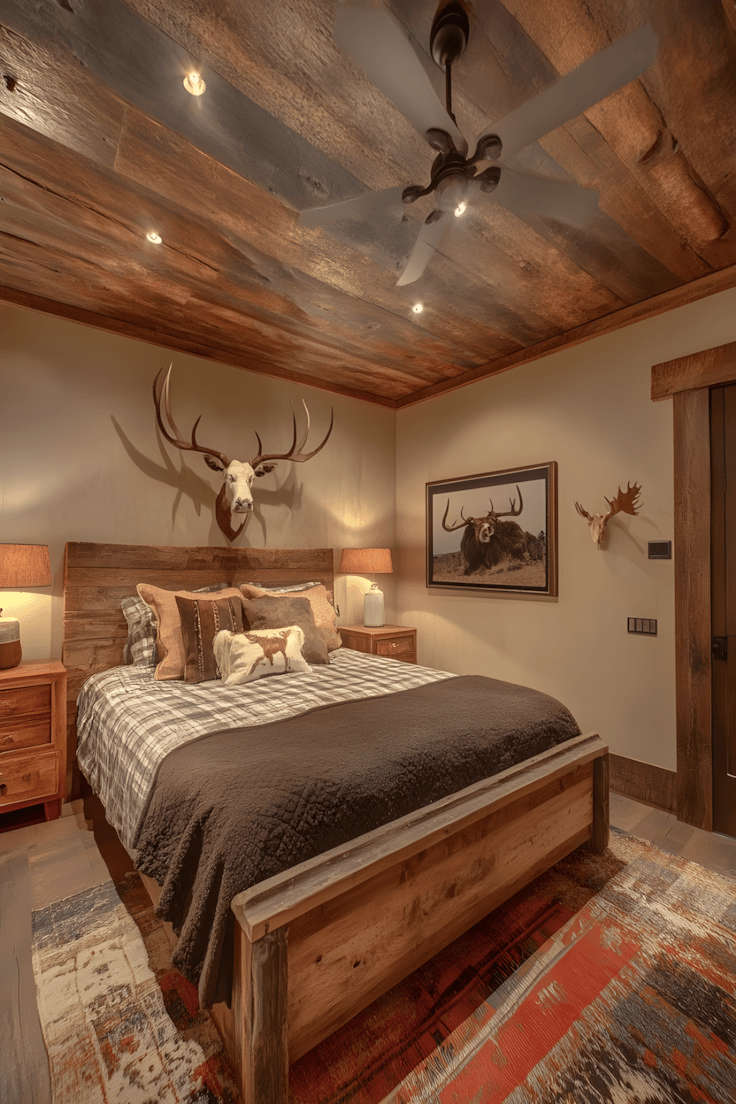
This approach incorporates outdoor themes through accessories and artwork. Checkered comforters can add traditional patterns, while wildlife photography or decorative elements reinforce nature connections.
Wooden nightstands with table lamps provide necessary bedside functionality while maintaining material consistency. The combination typically appeals to those wanting to celebrate outdoor activities and nature appreciation.
Theme consistency: When incorporating wildlife or outdoor themes, choosing elements that share similar color palettes often creates more cohesive results than mixing many different themes.
17. Dark and Luxurious Cabin Comfort
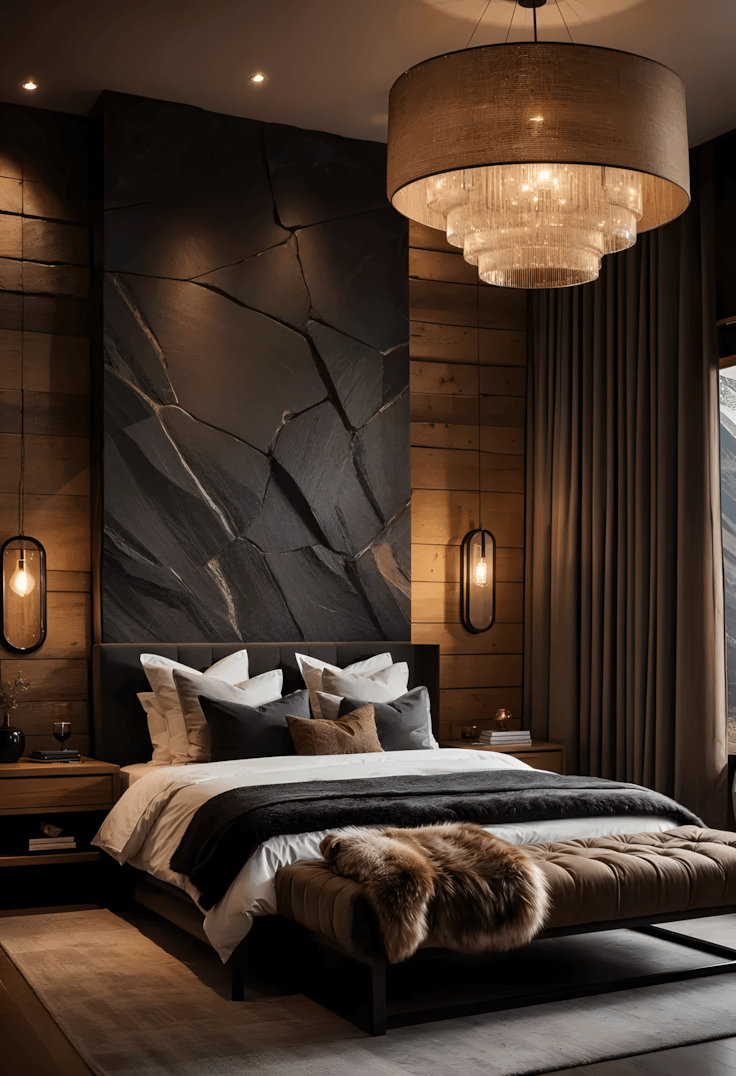
This sophisticated approach combines rustic materials with luxury finishes. Dark color palettes can create dramatic, cocoon-like environments, while modern pendant lights add contemporary functionality.
Black marble accent walls can provide striking contrasts while maintaining sophisticated aesthetics. The approach often works well for those wanting drama and elegance within rustic frameworks.
Lighting strategy: Dark color schemes require careful lighting planning to ensure adequate illumination for safety and functionality while maintaining the desired mood.
18. Vintage Charm in an Attic Bedroom
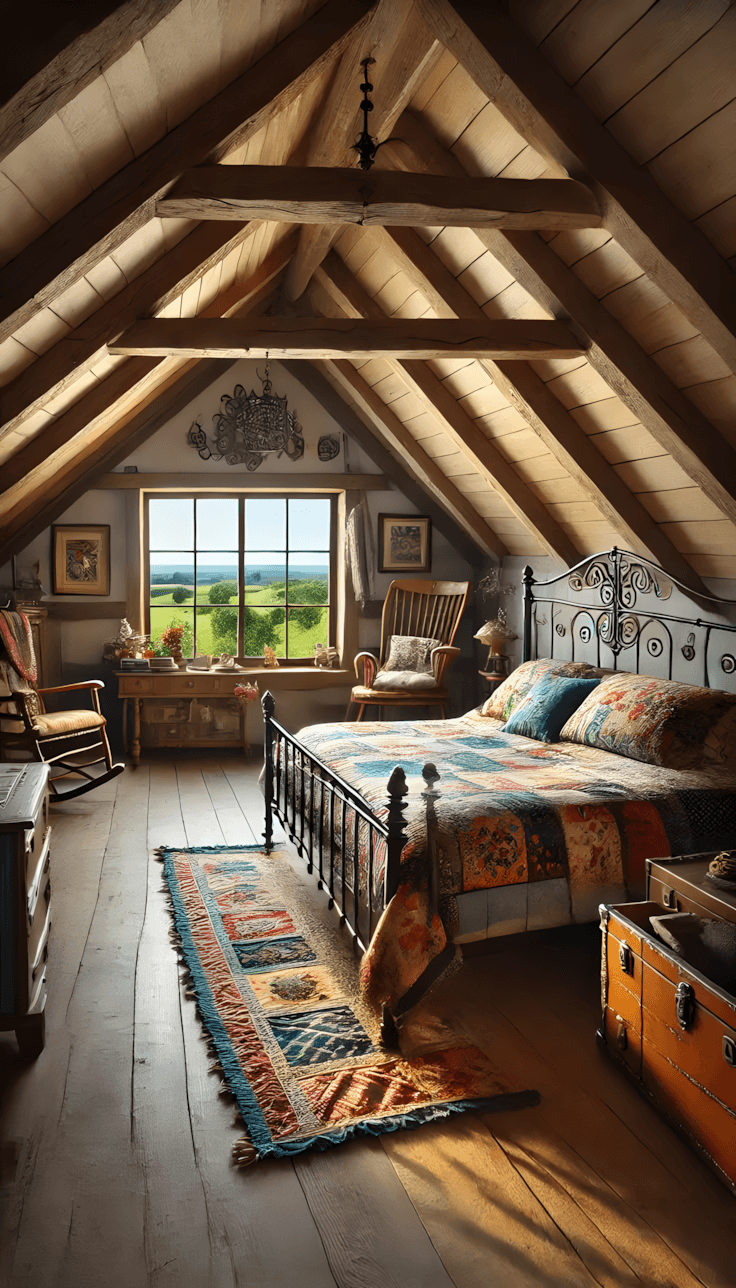
This nostalgic approach combines vintage furniture pieces with rustic architectural elements. Colorful quilts can add personality and warmth, while rocking chairs provide cozy seating options.
Small wooden tables can provide functional surfaces while maintaining scale appropriate for smaller spaces. The combination often appeals to those wanting homey, nostalgic feelings in their retreat spaces.
Scale consideration: In attic bedrooms, choosing furniture that fits the scale of the space helps prevent cramped feelings while maintaining functionality.
19. Rustic Meets Contemporary Design Integration
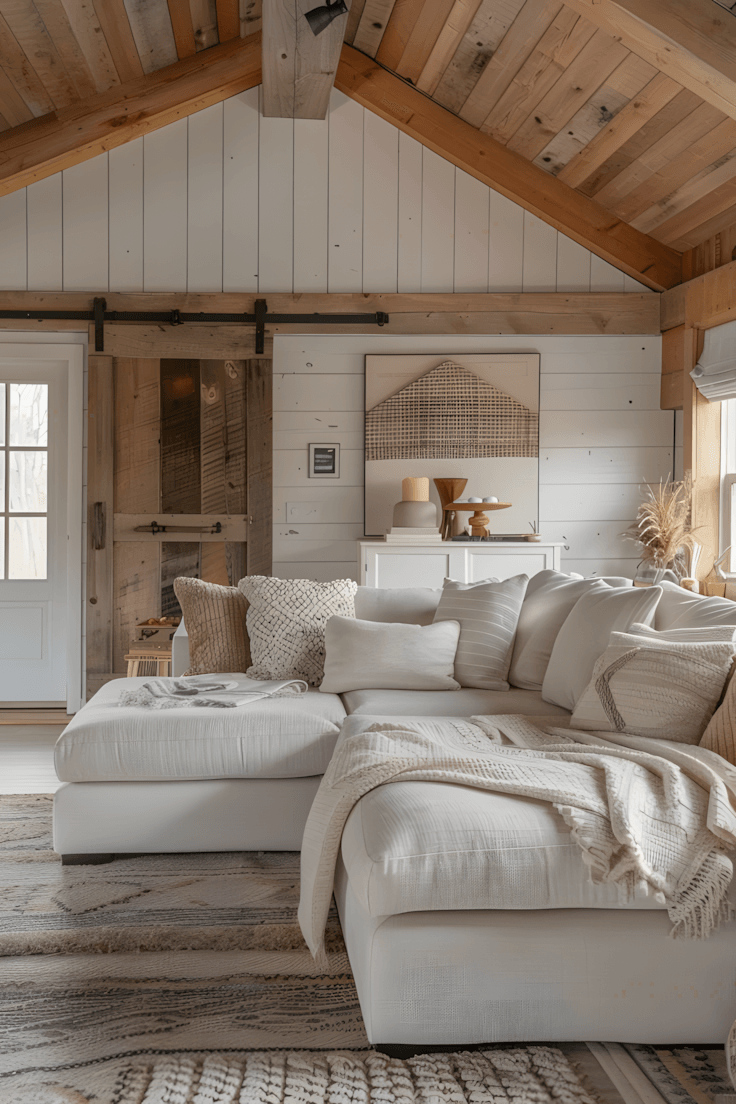
While this shows a living space rather than a bedroom, the principles apply to bedroom design. Clean, modern furniture lines can work effectively with rustic architectural elements when color palettes coordinate.
The balance between rustic materials and contemporary forms can create sophisticated results that feel both current and timeless. This approach often appeals to those wanting rustic warmth without sacrificing modern comfort.
Design philosophy: Successfully combining rustic and contemporary elements often requires finding common ground in color, scale, or materials rather than sharp contrasts.
20. Snowy Views in a Modern Rustic Bedroom

This contemporary approach uses modern elements within rustic frameworks. Multiple pendant lights can provide adequate task lighting while creating visual rhythm, and forest murals can reinforce nature connections without requiring maintenance.
Dark gray bedding can create sophisticated color palettes, while wooden ceilings maintain rustic warmth. Large windows maximize views and natural light, important elements for spaces emphasizing nature connections.
Modern rustic balance: Contemporary lighting and sophisticated color choices can update traditional rustic aesthetics while maintaining the cozy, natural feelings that make cabin styles appealing.
Creating Your Perfect Cabin-Inspired Bedroom Retreat
Based on various homeowner experiences, successful cabin-inspired bedrooms often happen when you choose elements that genuinely reflect your relationship with nature and comfort rather than simply copying trending styles.
Consider how you actually relax—do you prefer cozy, enclosed feelings or bright, airy environments? Do natural materials genuinely appeal to you, or do you prefer them mixed with more contemporary elements?
The most successful cabin-inspired bedrooms typically balance aesthetic appeal with practical considerations like maintenance requirements, lighting needs, and daily functionality.
Start by identifying which natural elements and color palettes genuinely make you feel calm and comfortable, then consider how they might work in your specific space and lifestyle.
Remember that bedrooms should primarily serve rest and relaxation, so choosing approaches that will promote good sleep and genuine comfort often provides better long-term satisfaction than focusing solely on visual appeal.
Final reminder: Cabin-inspired renovations may involve structural modifications, electrical work, and specialty installations that require licensed professionals. Always consult appropriate contractors and obtain necessary permits to ensure safety and code compliance.

